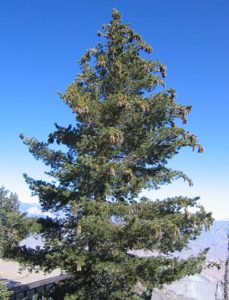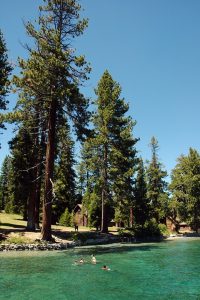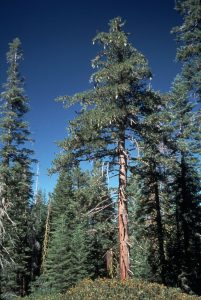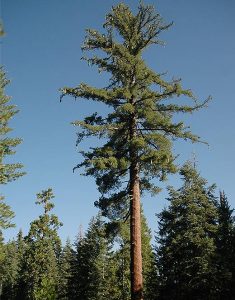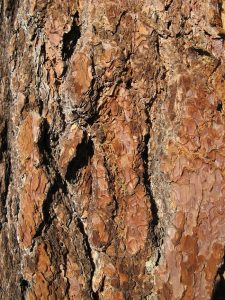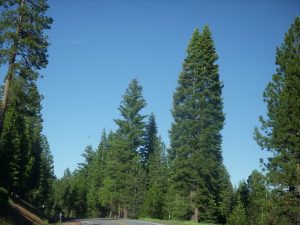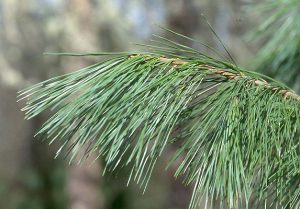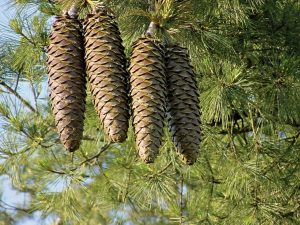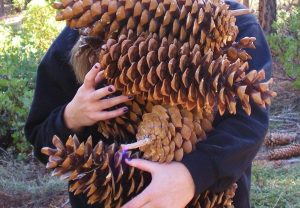Sugar Pine
Standing tall in the mountains, the Sugar Pine is a true giant of the forest. With towering heights that surpass many other pines, its massive, glistening cones stretch up to 20 inches long, making it a spectacle of nature. Often called the ‘king of the pines,’ this majestic tree offers more than just awe-inspiring beauty; it plays a critical role in the ecosystem and human industry alike.
The King of Pines
The Sugar Pine is not just a towering presence in North America’s mountains—it’s a symbol of resilience and magnificence. Known as the tallest of all pines, it can reach heights of over 200 feet in some cases, with cones that are the longest of any pine species. Native to the Sierra Nevada of California, this tree thrives in the cool, wet winters and dry summers, making it a staple of the mountainous landscapes it inhabits. Not only is it revered for its height and distinctive cones, but the tree also serves as an essential part of the local ecosystem, providing shelter and food for a variety of wildlife.
Scientific Classification of Sugar Pine
| Kingdom | Plantae |
| Division | Pinophyta |
| Class | Pinopsida |
| Order | Pinales |
| Family | Pinaceae |
| Genus | Pinus |
| Subgenus | Strobus |
| Scientific Name | Pinus lambertiana |
The Sugar Pine’s Physical Characteristics: A Towering Beauty
This unique pine is a giant of the conifer world. Its height can reach an impressive 130-195 feet, with some trees growing even taller, up to 273.79 feet—making it one of the tallest trees on Earth. The tree’s bark is thick and fire-resistant, an adaptation that protects it from frequent forest fires in its habitat. The Sugar Pine‘s cones are the longest in the world, ranging from 9.75 to 19.75 inches, and are glistening brown-yellow in color. Its needles grow in bundles of five, measuring 2.25 to 4.25 inches long, and its seeds are small, obovoid, and edible.
Key Features:
- Height: 130-195 feet (up to 273 feet)
- Bark: Thick, fire-resistant
- Cones: Longest pine cones (9.75-19.75 inches)
- Needles: Bundles of five, 2.25-4.25 inches
- Seeds: Edible, obovoid with broad wings
These characteristics make the Sugar Pine an iconic tree, admired for its size and beauty as well as its role in the forest ecosystem.
Quick Information on Sugar Pines
| Other Names | Sugar cone pine, big sugar pine, great sugar pine, ocote (Spanish), pino de azucar (Spanish) |
| Identification | Size: 130-195 ft (40-60 m)Trunk Diameter: 59-98 in (1.5-2.5 m) Leaves (Needles): Arranged in bundles of five with a sheath shed annually, 2.25-4.25 inches (5.7-10.8 cm) in length Cones: Longest cones in the world,9.75-19.75 inches (24.8-50 cm) in length, glistening brown-yellow in color Seeds: Obovoid (wedge-shaped), deep brown, 0.39-0.78 in (1-2 cm), with broad wings 0.78-1.18 in (2-3 cm) in length; edible Bark: Fire-resistant |
| Distribution/Range | Mountains of California and Oregon in the United States, Baja California in Mexico |
| Habitat | North and east facing slopes at elevations from sea level to 10,000 ft (3,050 m) |
| Hardiness Zones | Up to 7 |
| Growth Rate | Fast; average yearly growth of 2 ft |
| Lifespan | Typically 400-500 years |
| Growing Conditions | Winter Conditions: Cool, wet winters; temperatures upwards of -28°F (-33°C) Summer Conditions: Warm, dry summers; 5 frost-free months Rainfall: 25-90 in (63.5-228.6 cm) Soil: Coarse or medium textured, well-drained, acidic, moist soil Light Requirement: Sun to partial shade |
| Diseases & Pests | White pine blister rust, Melampsora rust, Lophodermellaarcuata, Phytophthoramegasperma, mountain pine beetle and sugar cone pine beetle |
| Breeding System | Monoecious |
| Propagation | Cuttings, seedlings, bare root and containers |
| Seedling Development | Prone to show signs of dormancy; easily fixed by cold stratification for 60-90 days |
| Wildlife Value | Nesting sites for birds, squirrels, and other small mammals |
| What is it used for | Wood is much sought after in lumber production; Native Americans use the sap to repair canoes; growing bonsai |
| IUCN Conservation Status | Least Concern |
Ecological Role: Sugar Pines Sustaining Wildlife and the Environment
These giants play a vital role in its ecosystem. The tall, dense canopy provides a rich habitat for various species of birds, squirrels, and small mammals. Its cones offer food for wildlife, and its branches provide shelter from the elements. The Sugar Pine‘s roots stabilize soil and reduce erosion, particularly in the steep, mountainous regions it calls home. As a pioneer species, it is one of the first to colonize disturbed areas, helping to restore the environment after forest fires or other disruptions.
Ecological Importance:
- Wildlife Habitat: Shelter and food for birds, squirrels, and small mammals
- Soil Stabilization: Roots prevent erosion, especially in mountainous terrain
- Restoration: Pioneer species that help restore ecosystems after disturbances
The Sugar Pine is essential to the balance of its ecosystem, supporting both plant and animal life.
Uses and Value: From Lumber to Cultural Significance of the Sugar Pine
The Sugar Pine is highly prized for its timber, which is known for being lightweight, straight-grained, and easy to work with. It’s commonly used in the production of furniture, cabinetry, and building materials. Historically, Native American tribes in California used the Sugar Pine‘s sap to repair canoes and baskets, highlighting its cultural significance. The tree’s wood and sap have been integral to local industries and cultures for centuries, and its continued use in construction and craftsmanship reflects its enduring value.
Uses of Sugar Pine:
- Timber: Lightweight, straight-grained wood used in furniture, cabinetry, and construction
- Cultural Significance: Native Americans used sap to repair canoes and baskets
- Bonsai: Grown for bonsai enthusiasts due to its aesthetic appeal
From the forest to human hands, the Sugar Pine‘s contributions are both practical and deeply embedded in cultural traditions.
Conservation and Challenges: Protecting the Sugar Pine
The Sugar Pine faces challenges, particularly from diseases like white pine blister rust and pests such as the mountain pine beetle. These threats have led to significant declines in the population of this iconic tree. Conservation efforts are underway, including breeding programs to develop rust-resistant varieties and active forest management to mitigate pest damage. However, continued monitoring and intervention are necessary to protect this remarkable tree.
Conservation Issues:
- Diseases: White pine blister rust, Melampsora rust, and others
- Pests: Mountain pine beetle, sugar cone pine beetle
- Conservation Efforts: Breeding rust-resistant trees and forest management strategies
Protecting the Sugar Pine requires concerted efforts to combat diseases and pests, ensuring that future generations can continue to admire this magnificent tree.
Interesting Facts
- The tallest sugar pine tree (273.79 ft) was discovered in October 2015, at Yosemite National Park, California by the giant tree hunter Michael Taylor.
- The United States Forest Service is currently involved in a program to develop rust-resistant sugar pine trees.
Summary: The Majesty and Importance of the Sugar Pine
The Sugar Pine stands as a towering testament to nature’s grandeur. Its impressive height, unique cones, and vital ecological role make it an essential tree in the forests of California and Oregon. From providing shelter and food to wildlife to contributing to the lumber industry, the Sugar Pine continues to shape the landscape around it. While it faces challenges from pests and disease, ongoing conservation efforts will help ensure that this majestic tree thrives for centuries to come.
References:
Published on January 17th 2017 by Sudipto Chakrabarti under Pine.
Article was last reviewed on 10th December 2024.


